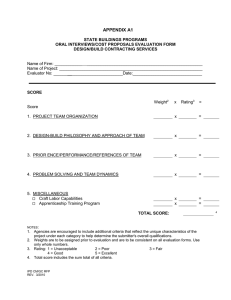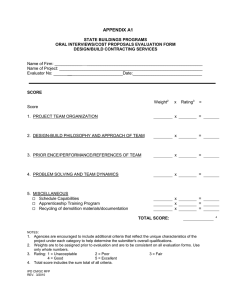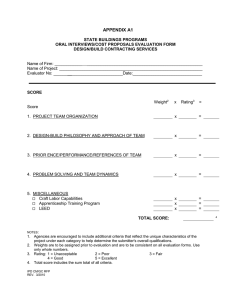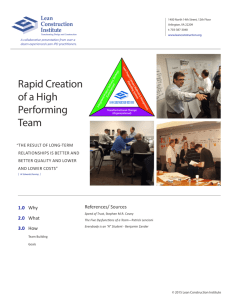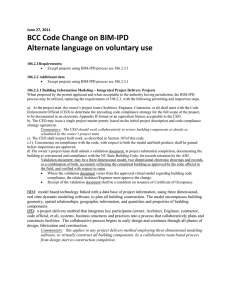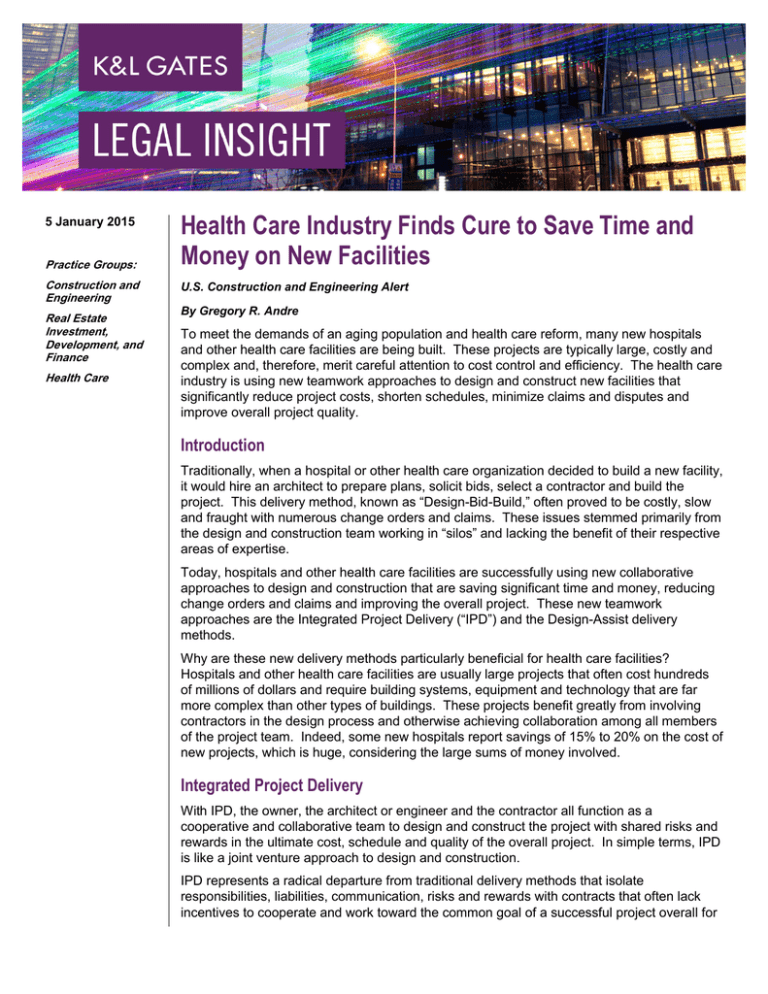
5 January 2015
Practice Groups:
Construction and
Engineering
Real Estate
Investment,
Development, and
Finance
Health Care
Health Care Industry Finds Cure to Save Time and
Money on New Facilities
U.S. Construction and Engineering Alert
By Gregory R. Andre
To meet the demands of an aging population and health care reform, many new hospitals
and other health care facilities are being built. These projects are typically large, costly and
complex and, therefore, merit careful attention to cost control and efficiency. The health care
industry is using new teamwork approaches to design and construct new facilities that
significantly reduce project costs, shorten schedules, minimize claims and disputes and
improve overall project quality.
Introduction
Traditionally, when a hospital or other health care organization decided to build a new facility,
it would hire an architect to prepare plans, solicit bids, select a contractor and build the
project. This delivery method, known as “Design-Bid-Build,” often proved to be costly, slow
and fraught with numerous change orders and claims. These issues stemmed primarily from
the design and construction team working in “silos” and lacking the benefit of their respective
areas of expertise.
Today, hospitals and other health care facilities are successfully using new collaborative
approaches to design and construction that are saving significant time and money, reducing
change orders and claims and improving the overall project. These new teamwork
approaches are the Integrated Project Delivery (“IPD”) and the Design-Assist delivery
methods.
Why are these new delivery methods particularly beneficial for health care facilities?
Hospitals and other health care facilities are usually large projects that often cost hundreds
of millions of dollars and require building systems, equipment and technology that are far
more complex than other types of buildings. These projects benefit greatly from involving
contractors in the design process and otherwise achieving collaboration among all members
of the project team. Indeed, some new hospitals report savings of 15% to 20% on the cost of
new projects, which is huge, considering the large sums of money involved.
Integrated Project Delivery
With IPD, the owner, the architect or engineer and the contractor all function as a
cooperative and collaborative team to design and construct the project with shared risks and
rewards in the ultimate cost, schedule and quality of the overall project. In simple terms, IPD
is like a joint venture approach to design and construction.
IPD represents a radical departure from traditional delivery methods that isolate
responsibilities, liabilities, communication, risks and rewards with contracts that often lack
incentives to cooperate and work toward the common goal of a successful project overall for
Health Care Industry Finds Cure to Save Time and Money
on New Facilities
everyone. Parties to an IPD team have incentives to do what is best for the project, rather
than what is best for themselves.
IPD typically utilizes Building Information Modeling, commonly referred to as “BIM.” BIM is
the use of a digital database to integrate the work of all of the design and construction project
team members and generate two- and three-dimensional models, plans and reports. Cost
and scheduling can be added to create fourth and fifth dimensions. It is a tool that facilitates
design collaboration and is intended to avoid conflicts and errors in plans.
IPD is an evolving delivery method based on broad concepts that can be customized on a
project-by-project basis. There is no such thing as one way to do a project by IPD, and there
is no need for a rigid definition of it, but it generally includes the following basic elements:
1. One Integrated Agreement: The core team members, typically the owner, the
architect/engineer and the contractor, all enter into a single contract. This is a much
different contractual arrangement from Design-Bid-Build in which the owner enters into
separate contracts with the architect/engineer and the general contractor.
2. Shared Risk and Reward: The core IPD team members manage and share risks and
rewards in the outcome of the project, usually its cost and time of completion, but other
performance standards can be established, such as energy efficiency. Part of the
compensation of the architect/engineer and the general contractor are usually contingent
on certain goals being met, and bonuses are paid for exceeding these goals.
3. Collaboration: With IPD, plans, schedules and other information is not only shared, but
developed jointly by the team. All parties, including the contractor, are involved from the
inception of the project. Some IPD projects literally use a so-called “big room” on site at
which all parties are stationed to facilitate collaboration.
4. Joint Decision-Making: IPD normally utilizes a committee approach to decision-making,
but the owner may reserve veto power.
5. Dispute and Liability Avoidance: A hallmark of IPD is minimizing the risk of disputes,
liability and litigation in order to foster collaboration and a teamwork environment. An
internal dispute resolution process is often followed as an initial step prior to mediation,
arbitration or litigation. The parties also typically agree upon various ways to reasonably
limit liability.
Design-Assist
Innovation in construction delivery methodology for health care is clearly trending toward
collaborative, teamwork approaches. Design-Assist is one such approach that requires
taking only a small step away from traditional delivery methods, such as Design-Bid-Build,
and avoids the leap required by IPD.
Design-Assist is a project delivery method in which the construction team is engaged by the
owner to collaborate with the architect or engineer during the design phase. The
construction team focuses on value engineering, constructability, cost estimating,
scheduling, procurement, BIM, maintenance and building life cycle. Participation by the
individual trade subcontractors in the design is intended to allow their specific construction
expertise to add value to the plans and reduce the cost and the schedule for the project.
Also, Design-Assist allows design issues to be discussed and resolved simply during the
design phase, instead of in the field during construction, when the stakes are much higher.
2
Health Care Industry Finds Cure to Save Time and Money
on New Facilities
Design-Assist is a unique delivery method because its focus is solely on the design phase of
construction (but it promises a positive effect on the entire project). It is used in conjunction
with, or incorporated into, other delivery methods. Hospital and other large health care
projects are prime candidates for Design-Assist due to their size and complexity. The
mechanical, electrical and plumbing (“MEP”) work constitutes roughly 40% of their overall
cost. Involving the MEP trades in the design can have a significant, positive effect on the
cost, schedule and quality of the project.
Some owners find IPD to be a very appealing delivery method, but are not willing to take the
leap to adopt all of its elements. Design-Assist is a step in the direction of IPD. It has some
of the attributes of IPD (teamwork, collaborative design process, etc.) and avoids the more
controversial elements of IPD (limited liability, joint decision-making, etc.). Design-Assist
may be the perfect alternative.
IPD and Design-Assist are relatively new and evolving project delivery methods. They are
part of what seems to be a growing trend toward heightened collaboration between the
design team and the construction team, and appear to be well-suited for hospitals and other
health care facilities.
Author:
Gregory R. Andre
greg.andre@klgates.com
+1.312.807.4254
Anchorage Austin Beijing Berlin Boston Brisbane Brussels Charleston Charlotte Chicago Dallas Doha Dubai Fort Worth Frankfurt
Harrisburg Hong Kong Houston London Los Angeles Melbourne Miami Milan Moscow Newark New York Orange County Palo Alto Paris
Perth Pittsburgh Portland Raleigh Research Triangle Park San Francisco São Paulo Seattle Seoul Shanghai Singapore Spokane
Sydney Taipei Tokyo Warsaw Washington, D.C. Wilmington
K&L Gates comprises more than 2,000 lawyers globally who practice in fully integrated offices located on five
continents. The firm represents leading multinational corporations, growth and middle-market companies, capital
markets participants and entrepreneurs in every major industry group as well as public sector entities, educational
institutions, philanthropic organizations and individuals. For more information about K&L Gates or its locations,
practices and registrations, visit www.klgates.com.
This publication is for informational purposes and does not contain or convey legal advice. The information herein should not be used or relied upon in
regard to any particular facts or circumstances without first consulting a lawyer.
© 2014 K&L Gates LLP. All Rights Reserved.
3

